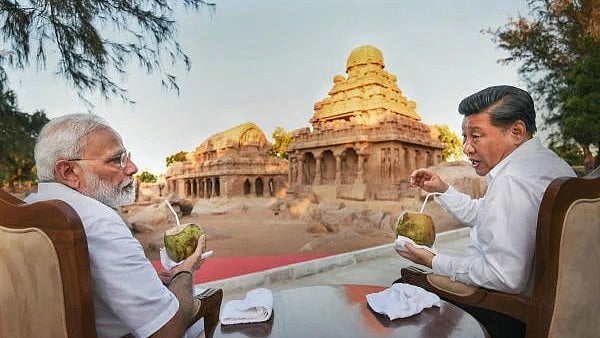
Narendra Modi with Chinese President Xi Jinping.
Credit: PTI File Photo
Prime Minister Narendra Modi’s fair-weather friend, United States President Donald Trump, let down and acted against India by imposing 25% additional tariffs on all Indian exports to the US. Trump threatened to put another 25% tariffs across the board to punish India for importing discounted Russian crude oil, largely as a bargaining chip to put Russian President Vladimir Putin on the mat for the war in Ukraine.
When it comes to ties with China, India has been smarting under unacknowledged losses suffered in border infringement and clashes with the Chinese in May 2020. Following this, India decided to boycott Chinese goods and not allow any Chinese investment in India. It’s clear that India completely distrusts China. However, after the above-mentioned betrayal by Trump, India is thinking of cosying up to China.
Will India be able to overcome its long and deep-seated distrust? Can it strike a business deal with China? Will it be a China plus US deal or a China minus US one?
Distrust of China
Be it on account of the 1962 War or the illegal occupation of large swaths of Indian territory over decades, or China’s rapid technological and trade advancement post-1978, and its admission to the WTO, Indian policymakers deeply distrust China.
In 2010, India refused to commission purchased Chinese Doppler radars, critical for monitoring weather and cyclonic conditions, on the suspicion that these radars contained chips and software which could transmit Indian data to China.
India was quite uncomfortable about thermal power plants established by private industrialists with Chinese technology, which were also financed by Chinese banks. These power plants became large non-performing assets (NPAs) of banks when the government did not provide coal linkages.
India has not allowed Chinese sovereign and other funds to make portfolio and private equity investments or acquire a majority stake in Indian companies.
In April 2020, Chinese investments in India were effectively shut out by Press Note 3, pushing all Chinese investment proposals to a dead end.
A bizarre consequence of a ‘zero Chinese investment’ policy has been consistently large merchandise trade deficit with China, touching $100 billion in 2024-2025.
US betrayal
Trump’s thoughtless and impossible asks, accompanied by India’s unimaginative and inflexible approach, led to the US imposing the highest tariffs on India. Indian exports to US are in grave danger of collapsing, causing enormous loss to exporters (the big trade surplus will disappear), loss of jobs, and a notable dent in India’s GDP growth.
The government could not protect the interests of farmers either. Fishermen are faced with significant losses as their exports to the US have become quite uncompetitive.
Trump has proved to be a disruptive force, not in the proverbial China shop, but in India’s.
Chinese tightening
Much before Trump’s tariff tantrums, China had started tightening the screws on India, which, in the last five years, has starkly brought out India’s dependence on China, especially for the new industrial economy.
India virtually banned imports of computers, laptops, etc. in August 2023 to reduce dependence on Chinese imports. The decision, however, had to be rescinded within hours, after it became clear that India’s IT services and domestic manufacturing industry were unable to sustain business without imports from China.
India tried to push domestic manufacturing of solar cells, modules, and batteries with large incentives under the Production Linked Incentive Scheme (PLI). These PLIs have made no progress on account of the Chinese vice-like grip on technology and core products.
New Delhi has not approved BYD’s request to manufacture EVs in India, while it’s trying desperately to get Tesla to manufacture in India. Nothing has worked. India’s EV transition is consequently one of the slowest in the world. Recently, China controlled the supply of rare earth magnets, which jolted Indian two-wheeler EV makers.
India’s call in 2020 to boycott Chinese products has made little impact. India’s trade deficit with China doubled from $48 billion in 2019-2020 to $100 billion last year.
Cautious cosying up
Some well-publicised moves signal a thaw in India-China political ties to build ground for resuming economic ties.
Foreign ministers of both countries have called on the top leadership of both countries. There are indications that supplies of rare earth magnets, fertilisers, etc. would be eased. Bilateral flights may resume soon. Modi is scheduled to visit China (after seven years) to attend the SCO summit, and also have a direct dialogue with Xi Jinping.
Beijing has played up US’ bullying and reiterated its interest in investing in India.
Do business with China
Without being distracted by political complications and historical distrust, India must reconfigure and restructure business and economic ties with China.
For that, New Delhi must withdraw Press Note 3 to permit Chinese investment in India on conditions applicable to investors from the US, Japan, and the EU. It must structure a deal which permits Indian companies to raise bonds freely in Renminbi to pay for imports from China. India must consider joining the RCEP by structuring a long-term path of tariff reduction and opening access with China. Finally, New Delhi must secure significant concessions for Indian service providers and personnel to have freer access to the Chinese market.
Keep option of US deal open
A deal with China should not be negotiated as a counter to the US-imposed tariffs. The tariffs are a temporary setback in India-US ties. Sooner or later, a healthy trade and investment relationship with the US will resume.
Subhash Chandra Garg is former Finance & Economic Affairs Secretary, and author of ‘The Ten Trillion Dream Dented’, ‘Commentary on Budget 2025-2026’, and ‘We Also Make Policy’.